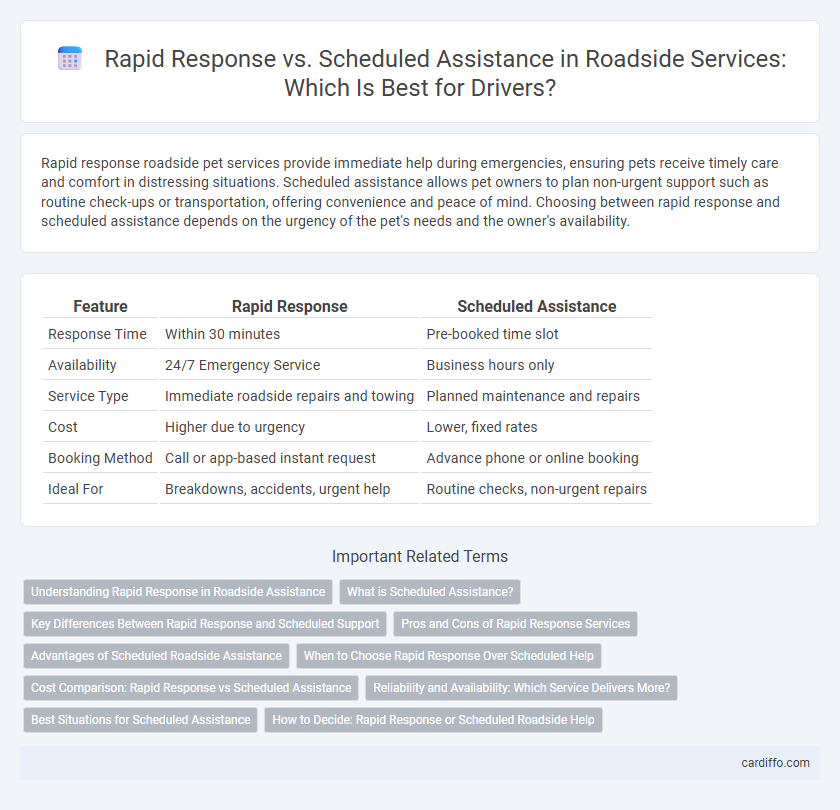Rapid response roadside pet services provide immediate help during emergencies, ensuring pets receive timely care and comfort in distressing situations. Scheduled assistance allows pet owners to plan non-urgent support such as routine check-ups or transportation, offering convenience and peace of mind. Choosing between rapid response and scheduled assistance depends on the urgency of the pet's needs and the owner's availability.
Table of Comparison
| Feature | Rapid Response | Scheduled Assistance |
|---|---|---|
| Response Time | Within 30 minutes | Pre-booked time slot |
| Availability | 24/7 Emergency Service | Business hours only |
| Service Type | Immediate roadside repairs and towing | Planned maintenance and repairs |
| Cost | Higher due to urgency | Lower, fixed rates |
| Booking Method | Call or app-based instant request | Advance phone or online booking |
| Ideal For | Breakdowns, accidents, urgent help | Routine checks, non-urgent repairs |
Understanding Rapid Response in Roadside Assistance
Rapid Response in roadside assistance emphasizes immediate, on-the-spot help to minimize vehicle downtime and ensure driver safety during unexpected breakdowns or accidents. It typically involves dispatching technicians or tow trucks within minutes, offering services like jump-starts, tire changes, fuel delivery, and lockout repairs. Understanding the efficiency of Rapid Response helps drivers choose services that prioritize quick resolution and reduce wait times compared to scheduled assistance appointments.
What is Scheduled Assistance?
Scheduled assistance refers to pre-arranged roadside service planned in advance to address non-emergency vehicle issues such as routine maintenance, battery checks, or minor repairs. This service ensures timely support during travel interruptions without the urgency of rapid response, which handles immediate breakdowns or accidents. Scheduled assistance enhances vehicle reliability by preventing unexpected roadside failures through regular maintenance appointments.
Key Differences Between Rapid Response and Scheduled Support
Rapid Response roadside assistance offers immediate support for urgent vehicle breakdowns, typically arriving within minutes to critical locations, ensuring swift resolution of emergencies. Scheduled Assistance is pre-arranged, providing planned maintenance or non-urgent repairs at a convenient time, prioritizing thorough service over speed. Key differences include response time, urgency level, and the nature of service, with Rapid Response focusing on emergencies and Scheduled Assistance catering to routine vehicle care.
Pros and Cons of Rapid Response Services
Rapid response roadside assistance provides immediate help, reducing wait times and minimizing vehicle downtime, which is critical during emergencies or in unsafe locations. However, rapid response services often come at a higher cost compared to scheduled assistance and may be limited in availability during peak hours or adverse weather conditions. While the speed of rapid response enhances safety and convenience, it may lack the thoroughness and planning of scheduled roadside assistance, impacting the service quality for complex repairs.
Advantages of Scheduled Roadside Assistance
Scheduled roadside assistance offers the advantage of pre-planned, reliable support tailored to vehicle maintenance schedules, reducing unexpected breakdowns and enhancing overall safety. This approach ensures timely inspections and repairs by licensed mechanics, preventing costly emergency interventions and minimizing downtime. Vehicle owners benefit from predictable service availability and cost-effective maintenance packages designed to extend the lifespan of their cars.
When to Choose Rapid Response Over Scheduled Help
Rapid response roadside assistance is ideal for urgent situations such as breakdowns on busy highways or severe weather conditions where immediate help ensures safety and minimizes downtime. Scheduled assistance suits non-critical issues like regular maintenance or minor repairs but delays can exacerbate problems if a vehicle becomes inoperable unexpectedly. Choosing rapid response helps prevent extended stranding and accelerates recovery during emergencies, leveraging real-time dispatch and priority service.
Cost Comparison: Rapid Response vs Scheduled Assistance
Rapid response roadside assistance typically incurs higher costs due to immediate dispatch and priority service, resulting in premium fees that cover expedited labor and parts delivery. Scheduled assistance offers a more economical option by allowing providers to plan resources and allocate labor efficiently, reducing operational expenses and passing savings onto customers. Comparing costs, rapid response suits urgent breakdowns with higher willingness to pay, while scheduled assistance meets budget-conscious drivers prioritizing low-cost maintenance.
Reliability and Availability: Which Service Delivers More?
Rapid response roadside assistance offers superior reliability with immediate deployment of help during emergencies, ensuring minimal wait times and reducing stress for drivers. Scheduled assistance, while reliable for planned maintenance, lacks the instant availability vital during unexpected breakdowns. Emergency roadside services with 24/7 rapid response capabilities demonstrate higher overall availability and dependability compared to scheduled assistance programs.
Best Situations for Scheduled Assistance
Scheduled assistance is ideal for non-urgent vehicle maintenance or repairs, such as routine tire changes, battery replacements, or diagnostic checks, where timing can be planned in advance. This approach minimizes wait times and ensures the availability of specialized tools and parts, providing a more efficient service experience. It suits situations where the vehicle is safely parked and not in immediate danger, allowing for convenient coordination with roadside service providers.
How to Decide: Rapid Response or Scheduled Roadside Help
Deciding between rapid response and scheduled roadside assistance depends on the urgency and nature of the vehicle issue. Rapid response is ideal for emergencies like sudden breakdowns or accidents requiring immediate help to ensure safety and quick resolution. Scheduled roadside help suits non-critical situations such as routine tow requests or minor repairs when timing flexibility allows for planned service.
Rapid Response vs Scheduled Assistance Infographic

 cardiffo.com
cardiffo.com